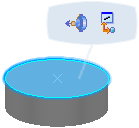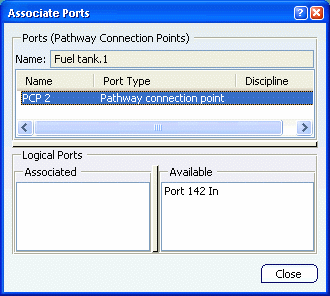Select the surface, edge or point of a 3D Shape containing at least one PCP.
A balloon appears.

Click Associate PCP  .
.
The Associate Ports dialog box appears.
Optional: Click Show or Hide Association Ports Dialog  to hide the dialog box.
to hide the dialog box.
Select a logical component or an equipment center in the RFLP tree or in the 3D viewer.
The name of the selected item is displayed in the dialog box. Pathway connection points
are listed under Ports and displayed in the 3D viewer. Any available logical ports are listed.

Note:
Equipment center pathway connection points can only be associated to logical ports of equipment in the equipment center.
Select a
logical port from the Available list or an unhighlighted port in the Ports folder in the RFLP tree.
The selected pathway connection point is associated with the selected port and the selected port appears in the Associated list.
Click Close when done.
You can see the PCP / Port association thanks to the cross-highlight between these elements.